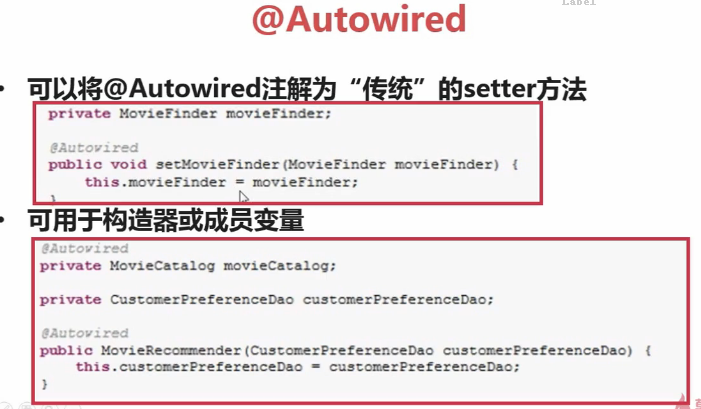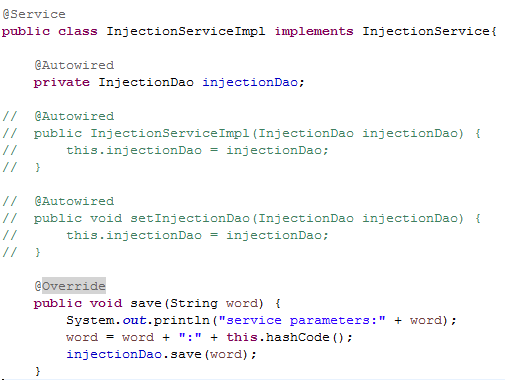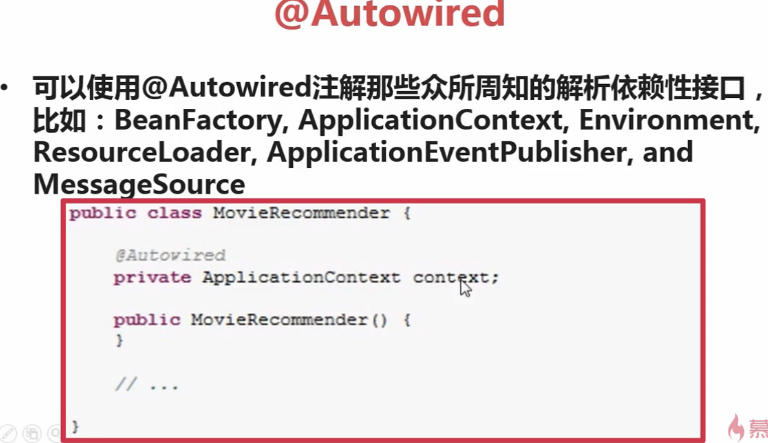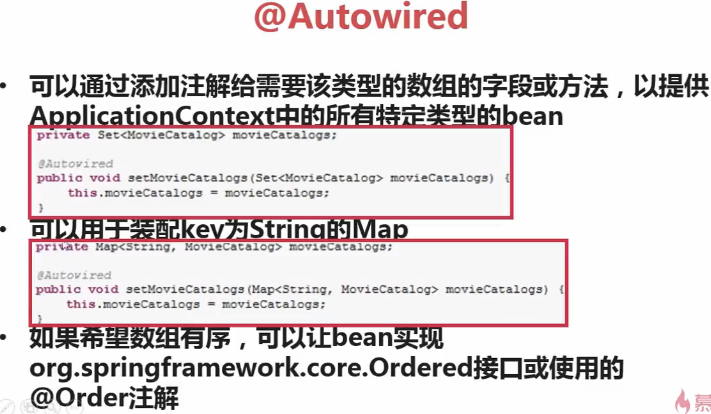@Required(不常用)

@Autowired(常用)


下面用例子解释以上内容:
@Autowired注解的三种方式如下,第一种是直接在属性名上加注解,这样就可以不用在写set方法进行注入,这种方式与set方式作用一样;第二种是在set方法上加注解;第三种是在构造器上加注解

测试代码如下:

xml配置文件正常即可:


图解:可以在当前类中,声明ApplicationContext的引用,然后可以用@Autowired进行注解,这时候可以在当前类中得到这个容器,并且可以使用这个容器了

图解:
数组也就是Set或List等,提供所有特定类型的bean是指:当Set中声明MovieCatalog时,当前的ApplicationContext中所有是Set泛型中声明类型的这种bean或它的子类,都可以被@Autowired注解,把这些bean的实例放到当前的集合当中。
这里的key也就是所有bean的id,value也就是bean的对象,同时我们希望放在Map或者是Set和List的集合中,这种bean的实例是有顺序的,可以实现以上接口来实现。

例子如下:
interface的两个实现类:


调用类实现:

1 @Component 2 public class BeanInvoker { 3 4 //可以利用@Autowired注解,将两个实现类的实例同时注入list或map中 5 //list中会被注解进来bean的实例,只有bean的对象 6 @Autowired 7 private List<BeanInterface> list; 8 9 //map中会被注解进来bean的id和实例,bean的id就是class的类名第一个字母小写 10 @Autowired 11 private Map<String, BeanInterface> map; 12 13 //将@Qualifier与@Autowired一起用,可以指定注入的某一个实现类的实例 14 @Autowired 15 @Qualifier("beanImplOne") 16 private BeanInterface beanInterface; 17 18 public void say() { 19 if(null != list && 0 != list.size()) { 20 System.out.println("list..."); 21 for(BeanInterface bean:list) { 22 System.out.println(bean.getClass().getName()); 23 } 24 } 25 else { 26 System.out.println("List<BeanInterface> list is null...."); 27 } 28 29 System.out.println(); 30 31 if(null != map && 0 != map.size()) { 32 System.out.println("map..."); 33 for(Map.Entry<String, BeanInterface> entry:map.entrySet()) { 34 System.out.println(entry.getKey() + "......" + entry.getValue().getClass().getName()); 35 } 36 } 37 else { 38 System.out.println("Map<String, BeanInterface> map is null..."); 39 } 40 41 System.out.println(); 42 43 if(null != beanInterface){ 44 System.out.println(beanInterface.getClass().getName()); 45 } 46 else { 47 System.out.println("beanInterface is null..."); 48 } 49 } 50 }
测试类:

注释:当某个接口有多个实现类时,可以将@Qualifier与@Autowired一起用, 指定应该注入的对象的实例。@Qualifier中应该是要指定注入的bean的id
打印结果如下:


